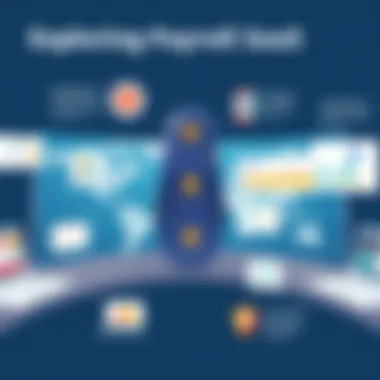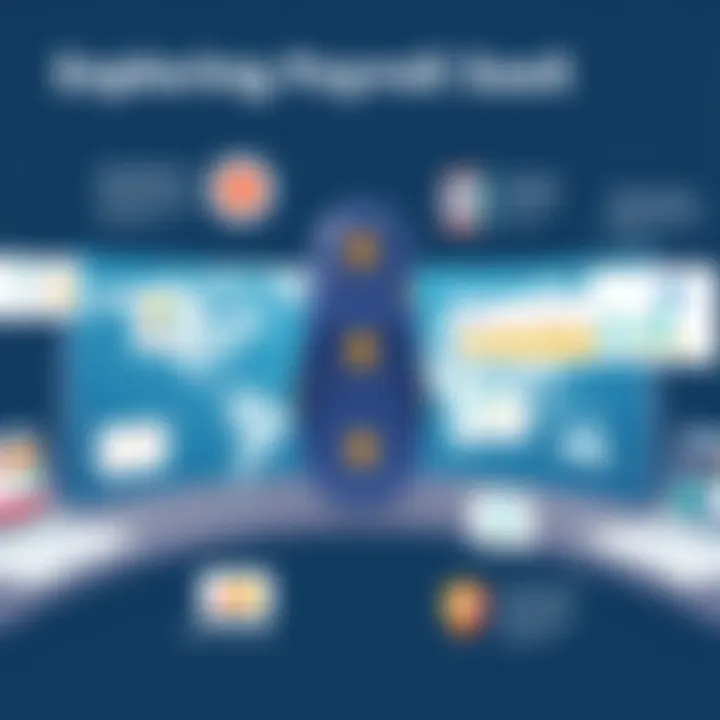Navigating Global Payroll SaaS: A Comprehensive Guide


Industry Overview
The landscape of global payroll SaaS has transformed remarkably over the years. As businesses expand their operations across various geographical boundaries, the complexity of managing payroll has increased substantially. No longer can companies rely on traditional payroll methods. They face challenges such as differing regulations, diverse taxation systems, and varying employee needs.
Current Trends in the Industry-specific Software Market
Today, companies are leaning into cloud-based solutions as a means to manage their payroll functionalities smoothly. This shift towards global payroll SaaS is not just about convenience; it’s about achieving accuracy and compliance in an ever-evolving market.
Some distinctive trends include:
- Automation: Automating payroll processes minimizes manual errors. This trend is not merely a luxury but a necessity in maintaining efficiency.
- Mobile Access: Employees now demand transparency. They want to access their payroll information on their phones. This expectation is fostering the development of mobile-friendly SaaS solutions.
- AI Integration: The rise of Artificial Intelligence in SaaS is shifting how payroll operations work. AI aids in predictive analytics which assists in forecasting labor costs and managing budget allocations.
Key Challenges Faced by Buyers in the Industry
While exploring global payroll SaaS options, buyers encounter several roadblocks.
- Compliance Risks: Navigating countless regulations that vary by country is daunting. A simple misstep can lead to hefty fines.
- Integration Issues: Many businesses run on legacy systems that resist integration with modern software solutions. This resistance can create fragmented data management practices.
- Cost Concerns: Effective SaaS solutions often come with a price tag. Small businesses may weigh the cost versus the potential ROI before making a leap.
Emerging Technologies Impacting the Industry
Emerging technologies are reshaping payroll software in countless ways. Blockchain, for instance, introduces enhanced security, ensuring integrity in payroll transactions. Additionally, machine learning can streamline processes such as tax calculations and compliance monitoring. By embracing these technologies, businesses can not only simplify processes but also enhance their overall financial integrity.
In summary, the industry of global payroll SaaS is evolving rapidly, and keeping pace with its transformations is crucial. The implications for compliance, efficiency, and cost-effectiveness impact decisions that resonate throughout organizations.
Understanding Global Payroll SaaS
In an age where businesses often stretch beyond national boundaries, the role of global payroll systems cannot be overstated. These systems address the complexities of employing a diverse workforce spread across various jurisdictions. Understanding Global Payroll SaaS is essential for organizations aiming to streamline their payroll processes while ensuring compliance with different local laws and regulations. The significance lies not only in operational efficiency but in easing the burden on HR departments and improving employee satisfaction by providing predictable and accurate payroll services.
Definition of Payroll SaaS
Payroll Software as a Service (SaaS) refers to cloud-based payroll solutions that allow businesses to manage their payroll processes online. Instead of relying on traditional software installed locally on computers, Payroll SaaS provides access through the internet, enabling features such as automatic updates and easier scalability. Essentially, organizations subscribe to a service rather than invest heavily in software and hardware.
This model appeals to businesses of all sizes because it's flexible and often comes at a lower up-front cost compared to traditional systems.
Comparison with Traditional Payroll Systems
When it comes to managing payroll, the choice between a traditional system and Payroll SaaS can be like comparing apples to oranges. Here are some key differences:
- Cost Efficiency: Traditional systems often involve hefty initial purchase prices, ongoing maintenance, and upgrade costs. Payroll SaaS typically operates on a subscription model, which can be more budget-friendly over time.
- Accessibility: With traditional systems, access can be limited. However, Payroll SaaS can be accessed from anywhere with an internet connection, making it favorable for remote teams.
- Updates and Compliance: In traditional setups, keeping software updated to comply with changing regulations can be a daunting task. Payroll SaaS providers handle updates and compliance changes automatically, ensuring businesses don't fall behind.
- Scalability: As organizations grow, scaling traditional systems can be cumbersome and costly. On the other hand, scaling Payroll SaaS is often just a matter of adjusting the subscription as needed.
Importance of Global Payroll Solutions
In today’s interconnected world, the significance of global payroll solutions cannot be overstated. As businesses expand beyond borders, they encounter diverse regulatory requirements and cultural nuances that complicate payroll processes. This complexity demands a sophisticated approach to managing payroll, where global payroll Software as a Service (SaaS) steps in as a vital tool. Here’s a closer look at why these solutions are critical in today’s business landscape.
Meeting Diverse Payroll Needs
A key feature of global payroll SaaS is its ability to cater to the varying payroll needs of different countries. Each region has its own labor laws, taxation systems, and employee benefits, which can be daunting for companies operating internationally. By utilizing a global payroll SaaS solution, businesses can:
- Tailor payroll calculations to meet local tax regulations and compliance requirements.
- Integrate multiple currencies without missing a beat, allowing for easy processing across financial systems.
- Adapt to changing laws, as many providers update their platforms automatically to reflect the latest legal requirements, which minimizes the risk of non-compliance.
This adaptability ensures that companies not only stay compliant but also foster strong employee relations by ensuring that employees are compensated fairly and accurately.
Enhancing Operational Efficiency
Operational efficiency is a pivotal element where global payroll solutions shine. Streamlined payroll processes allow companies to allocate resources more effectively. When payroll runs smoothly, it reduces administrative burdens on HR departments. Here are a few aspects of how payroll SaaS enhances efficiencies:
- Automation of repetitive tasks: These tools take the drudgery out of payroll processing. Automation means fewer errors and quicker turnaround times.
- Centralized data management: With cloud-based systems, all payroll data can be accessed from a single dashboard, enabling employers to make data-driven decisions faster.
- Reporting capabilities: Real-time reporting functionalities help teams analyze their payroll processes and identify areas for improvement, ultimately saving time and money.


Enhancing operational efficiency isn’t just about saving time; it leads to a smoother workflow and improved job satisfaction within the workforce.
Support for Remote Workforces
The rise of remote workforces has shifted how companies manage payroll. Global payroll solutions provide essential support to organizations with distributed teams. Employers can manage payroll across different time zones, for instance. This capability means that payroll can be processed timely, regardless of where employees are located. Furthermore:
- Accessibility: Employees can access their payroll information at any time through self-service portals, reducing the time HR spends responding to queries.
- Flexible payment methods: Many SaaS providers allow companies to disburse salaries through various channels, including digital wallets, direct deposits, and international wire transfers. This variety addresses the needs of global teams.
- Documentation and compliance: By ensuring that all payroll documentation is easily generated and compliant with local laws, these tools assist remote teams in navigating complex international regulations.
"Investing in global payroll solutions is investing in the foundation of your workforce’s trust and efficiency. It’s where efficiency meets worker satisfaction."
Core Features of Payroll SaaS Platforms
The growing need for modern businesses to maintain agility in payroll processing has led to the advent of powerful Payroll SaaS platforms. These systems are designed not merely to execute payroll functions, but to integrate various aspects of workforce management in a seamless way. Understanding these core features is vital for decision-makers, as they help ensure organizations select a platform that aligns with their operational needs.
Automation of Payroll Processing
With automation at the forefront, Payroll SaaS platforms dramatically simplify payroll processing. Instead of spending countless hours on manual calculations and paperwork, businesses can set up automated workflows that ensure timely and accurate payroll execution.
This automation encompasses:
- Calculation of salaries, bonuses, and deductions without manual input, reducing the potential for errors.
- Scheduled payments that align seamlessly with banking systems, ensuring employees receive their payments on time.
- Automatic generation of reports, which can be crucial during audits.
"In an age where time is as precious as gold, automation removes the shackles of manual processes."
Ultimately, automating payroll processing not only streamlines operations, but also frees up HR professionals to focus on more strategic tasks.
Compliance Management Tools
Staying compliant with local and international regulations is a challenge that every global business faces. Payroll SaaS providers are equipped with compliance management tools that help mitigate this risk.
These tools offer:
- Real-Time Updates: Frequent updates enable businesses to remain aligned with ever-changing regulations across different regions.
- Tax Compliance: Automatic calculation of taxes based on local laws ensures that organizations can avoid costly penalties.
- Historical Records: Maintaining an audit trail for past payroll data simplifies reporting and verification during inspections.
These compliance features provide peace of mind, reducing the headaches often associated with regulatory burdens.
Employee Self-Service Portals
Employee self-service portals represent a pivotal feature in Payroll SaaS platforms, allowing employees direct access to their payroll information. Offering these portals not only enhances employee satisfaction but also optimizes HR functions through decreased query volumes.
These portals typically include functionalities such as:
- Access to Payslips: Employees can easily view and download their payslips, ensuring they have immediate access to their earnings information.
- Time-Off Requests: Employees can submit vacation or sick leave requests through the platform, streamlining the approval process.
- Personal Information Management: Employees can update their personal details directly, making HR's job easier while ensuring accuracy in records.
By empowering employees in this way, organizations can enhance transparency and foster a sense of ownership and responsibility.
In summary, the core features of Payroll SaaS platforms revolutionize how businesses manage payroll. Automation, compliance management, and self-service capabilities deliver efficiency and accuracy, equipping organizations to meet the complexities of today’s workforce demands.
Choosing the Right Global Payroll SaaS Provider
When it comes to selecting a global payroll software as a service (SaaS) provider, decision-makers face a daunting challenge. The impact of this choice ripples through every aspect of business operations. From compliance with local laws to employee satisfaction, getting it right is paramount. In today’s fast-paced business ecosystem, the provider you choose can either streamline your operations or introduce significant inefficiencies. Therefore, it’s crucial to evaluate various elements to find the provider that fits not only the needs of your organization but also aligns with your global ambitions.
Key Considerations in Selection
Choosing a payroll SaaS provider involves careful consideration of several factors:
- Scalability: As your business grows, your payroll needs may expand. A provider must accommodate changes without excessive costs or complexity.
- Compliance: Payroll regulations vary significantly across regions. The solution must stay updated with the latest regulations, which requires thorough research on compliance capabilities.
- User Experience: The interface should be intuitive. If employees find the system cumbersome, it could lead to errors and decreased satisfaction.
- Customer Support: Look for providers that offer responsive support among different time zones. In business, time is money, and delays in resolving payroll issues can lead to serious consequences.
- Integration Capabilities: Check how well the payroll solution integrates with existing HR systems, accounting software, and other critical applications. Disjointed processes can lead to inefficiencies.
- Data Security: Since payroll involves sensitive data, evaluating the security measures of a provider is non-negotiable.
These considerations help in creating a shortlist that can possibly meet your organization's unique needs.


Comparison of Leading Providers
Among the myriad of payroll SaaS providers, a few stand out for their robust offerings. For instance,
- ADP: Known for its extensive global coverage and compliance tools, ADP is widely respected in the industry. It's especially useful for organizations with a significant employee base across multiple countries.
- Gusto: This platform is often favored by startups and small businesses due to its user-friendly interface and strong customer service. It simplifies the setup process, making it accessible even for less tech-savvy users.
- Paycor: Focusing on medium-sized businesses, Paycor boasts strong analytics features along with excellent scalability that can cater to growing organizations.
"Selecting the right provider is more than a transactional decision; it's a strategic one that shapes the very fabric of your operational efficiency."
Comparing the costs, features, and client reviews of each provider is essential. Don’t overlook demos or trial periods, as they can illuminate the user experience far better than brochures or websites.
Case Studies of Successful Implementations
To shed light on how effective the right payroll SaaS solution can be, consider these examples:
- A Tech Startup: Facing rapid growth, a tech startup implemented Gusto. The decision was based on Gusto's ability to adapt quickly to their scaling needs. Within a few months, automating payroll reduced their administrative hours by over 40%.
- An International Manufacturing Firm: Opted for ADP, allowing them to navigate complex compliance issues across ten countries easily. This choice drastically reduced errors in payroll processing, which in turn improved employee trust and satisfaction.
These case studies not only illustrate the importance of choosing the right provider but also point to the broader implications of such strategic decisions. Doing due diligence can make all the difference in achieving your global payroll objectives.
Integration of Payroll SaaS with Existing Systems
Integrating Payroll Software as a Service (SaaS) with existing systems is not just a nice-to-have; it is a necessity for businesses looking to streamline their operations. Transitioning to a SaaS platform can often feel daunting, especially when organizations have established systems that manage critical functions. However, successful integration paves the way for improved efficiency, enhanced data accuracy, and a more cohesive technological ecosystem.
The value of integration lies not just in merging various tools, but in creating a seamless flow of information across departments. When payroll data syncs with human resources, accounting, and other enterprise systems, employers can minimize errors and ensure compliance with financial regulations.
In essence, effective integration transforms disparate data pools into a unified platform that allows for real-time access to crucial payroll information. This consolidation of data enables richer analytics and reporting capabilities, which can lead to more strategic decision-making.
An organization's ability to identify integration needs is vital when selecting a Payroll SaaS solution. Such needs stem from the specific operational realities of the business. This process requires an understanding of existing workflows and how payroll fits into the larger picture.
Identifying Integration Needs
Identifying what systems a Payroll SaaS must connect with is a foundational step for a successful implementation. The first order of business is to assess the current software landscape. Companies typically rely on various tools for different functions—human resources management, time tracking, financial software, or even customer relationship management. Knowing how these systems interact is crucial.
Once you outline the existing systems, consider the following aspects:
- Data Flow: Determine how data moves between current systems and what manual tasks are eliminated—or, conversely, how new tasks may arise.
- User Roles: Identify who will need access to payroll information. Integrating based on user roles ensures that only authorized personnel see sensitive data.
- Business Goals: Aligning integration needs with overarching business objectives not only adds value but can also justify the associated costs.
This initial assessment creates a roadmap guiding the integration process, ensuring that the new Payroll SaaS complements existing operations rather than complicating them.
Utilizing APIs for Seamless Connectivity
Once the integration needs are laid out, utilizing Application Programming Interfaces (APIs) becomes the backbone of effective connectivity between systems. APIs serve as bridges, facilitating the real-time exchange of data between the Payroll SaaS platform and other software applications.
The beauty of APIs lies in their capability to automate data transfer. For instance, when an employee’s details are updated in the HR system, the integrated Payroll SaaS can automatically reflect this change, preventing any odds of conflicting information. This automation can significantly reduce administrative burden, saving both time and effort.
Consider the following benefits of using APIs in integration:
- Real-Time Data Synchronization: By allowing systems to communicate instantly, APIs ensure accurate and timely payroll processing.
- Scalability: As businesses grow, their integration needs may evolve. APIs provide the flexibility to connect with new applications without extensive reconfiguration.
- Enhanced Security: With well-designed API protocols, sensitive data transfer can be secured, helping to address compliance issues while safeguarding personal information.
To summarize, APIs play a critical role in achieving the seamless connectivity needed for effective business operations. They not only enhance efficiency but also create a more robust and secure operational framework, positioning the organization for better growth in the ever-competitive global market.
"Integration is not just a technical challenge; it's also a strategic imperative for businesses that aim to stay ahead in the game."
Challenges in Implementing Global Payroll Solutions
In today’s increasingly interconnected world, global payroll solutions offer a significant edge for businesses operating across borders. However, the transition to these advanced systems is not without its hurdles. Understanding the challenges involved in implementing global payroll SaaS is crucial for organizations aiming to streamline their payroll processes while managing the complexities brought by different jurisdictions and workforces.
Data Security Concerns


In the digital age, where data breaches make headlines almost daily, protecting sensitive employee information is a top priority for organizations. Implementing global payroll solutions raises significant data security concerns that cannot be overlooked. Payroll systems handle sensitive data, including personal employee information, tax details, and banking information.
Companies must ensure rigorous security measures are in place. This includes encryption, multi-factor authentication, and regular security audits to safeguard data against unauthorized access. Furthermore, companies need to be proactive in identifying vulnerabilities and ensuring compliance with international data protection regulations, like the General Data Protection Regulation (GDPR) in Europe.
"Data breaches are not just technical issues; they pose a significant reputational risk to organizations. Protecting employee information is not merely a compliance issue; it directly impacts the trust between employer and employee."
Navigating Regulatory Compliance
Navigating the labyrinth of regulatory compliance is another major challenge when adopting global payroll solutions. Different countries have varying labor laws, tax regulations, and compliance requirements. For instance, what is compliant in the United States may not be acceptable in Canada or Australia. With global payroll SaaS, businesses must stay up-to-date with the ever-evolving regulatory landscape in each jurisdiction where they operate.
This demands significant resources and expertise, both in terms of human resources and technology. Failure to comply with local regulations can lead to hefty fines and legal repercussions. To mitigate these risks, organizations must invest in compliant payroll systems that automatically update to reflect changes in laws and regulations across different regions. A robust compliance framework is essential for maintaining a smooth operational flow and minimizing potential disruptions.
Managing Cultural Differences
Despite technological advancements, the human element remains a significant factor in global payroll management. Managing cultural differences can be complicated when implementing a payroll solution that caters to a diverse workforce. Each country has its unique customs, expectations, and work cultures, which can impact how payroll is processed and perceived by employees.
For example, in some cultures, employees may expect more transparency regarding their payroll process, while in others, it might be less rigid. It’s essential to tailor payroll communication strategies to fit local expectations, ensuring employee satisfaction and engagement. Moreover, fostering a company culture that values inclusivity can help bridge cultural gaps, creating a more cohesive working environment.
In summary, while global payroll SaaS provides many advantages, addressing data security, regulatory compliance, and cultural differences is vital. By recognizing and tackling these challenges head-on, businesses can successfully navigate the complexities of implementing global payroll solutions and enjoy the benefits that come with it.
The Future of Global Payroll SaaS
As we look towards the horizon of global payroll, the conversation shifts towards the innovative solutions that define the future of Payroll Software as a Service (SaaS). The importance of understanding this dynamic landscape can't be downplayed in today's business environment, especially considering the rapid pace of technological advancements. With globalization and remote work becoming the norm, it's crucial for decision-makers and IT professionals to grasp the emerging trends and innovations shaping payroll systems.
Emerging Trends in Payroll Technology
The payroll technology landscape is evolving at breakneck speed. One trend that stands out is the push towards cloud-based solutions that enhance accessibility. Businesses globally are shifting their payroll functions to the cloud, allowing real-time updates and immediate access to needed information. This transitioning affords organizations not just efficiency but also the ability to manage payroll from virtually anywhere, which is vital for companies with remote workforces.
Moreover, integration capabilities are taking center stage. Companies are increasingly keen on platforms that can seamlessly connect with existing systems. Such integration minimizes data redundancy and errors, while ensuring comprehensive data analysis. Imagine a payroll system linking effortlessly with human resources and accounting software—this is becoming less of a luxury and more of a necessity.
The integration of blockchain technology is also a rising star. It's touted for its ability to enhance security and transparency in transactions. Once companies understand how to leverage blockchain, the potential for preventing fraud or logistical errors increases exponentially.
"The payroll sector is not just catching up; it's at the forefront of a digital revolution that enhances efficiency and compliance."
It’s not all about tools and functionalities; companies are now focusing on user experience. Payroll systems that prioritize ease-of-use attract more engaged general users and foster compliance. Intuitive interfaces allow employees to navigate their payslips and tax documents with relative ease. This user-centric approach could cultivate a culture of compliance, reducing errors that often stem from user confusion.
The Role of Artificial Intelligence
Artificial Intelligence (AI) is reshaping payroll in profound, groundbreaking ways. It's not merely a buzzword—AI is a game-changer in how organizations manage payroll, compliance, and data analysis. Its applications range from simple task automation to complex data insights that can inform business decisions.
For instance, AI algorithms can predict payroll-related issues before they arise. Consider a scenario where an organization uses AI to analyze data trends—if anomalies appear, the system can alert relevant personnel, allowing them to take corrective action before complications escalate. Businesses can therefore remain proactive rather than reactive.
Additionally, chatbots are beginning to assist HR teams in addressing payroll inquiries swiftly. By handling common questions, AI-driven chat systems can free up valuable time for HR professionals, allowing them to focus on more strategic tasks. If you've ever waited on hold for payroll information, you understand the relief a quick response could provide.
Finally, AI can streamline compliance management. With regulations constantly changing, organizations find it hard to keep pace. AI can automate updates to compliance documents, ensuring that organizations are always in line with local and international regulations.
Ending
In a world where businesses are increasingly operating on a global scale, the importance of choosing the right payroll SaaS cannot be overstated. The transition to a digital payroll solution offers not just convenience, but also a strategic advantage that can boost overall operational efficiency. A well-implemented payroll SaaS can harmonize processes across diverse regions, ensuring consistency and compliance while catering to the unique demands of each local jurisdiction. Moreover, integrating payroll software can lead to significant cost savings, as well as freeing up valuable time for HR teams, allowing them to focus on more strategic initiatives.
The future of payroll management lies in the hands of technology. To put it simply, companies ignoring this trend might find themselves outpaced by competitors who leverage these advanced solutions.
Summary of Key Points
When summarizing the essential aspects from the earlier sections, it’s clear that:
- Global Compliance: Payroll SaaS solutions are built to navigate the complex landscape of local regulations. This capability ensures businesses can minimize the risk of non-compliance penalties and fines.
- Operational Efficiency: Automation of repetitive tasks leads to increased accuracy and a reduction in processing times.
- Support for Distributed Workforces: The rise of remote working necessitates a robust system for payroll management that can accommodate various employee needs and locations.
- Integration Capabilities: Seamless API connections allow existing systems to work in concert with new payroll tools, minimizing disruption.
- Future Insights: Anticipating trends in technology, including the adoption of AI and machine learning, can set businesses apart in effectively managing payroll operations.
Final Thoughts on Choosing Payroll SaaS
In deciding upon a payroll SaaS platform, there are several crucial considerations. First, evaluate the specific needs of your organization. What are the unique challenges you face concerning payroll management? Engaging with a provider who understands your particular industry can be beneficial. Furthermore, prioritize user experience; the system must be intuitive not just for HR personnel but also for employees. A clunky interface can hinder adoption and lead to frustration.
Another aspect to consider is vendor support. Having a reliable point of contact to resolve any issues that crop up during the implementation phase and beyond is indispensable. Additionally, delve into customer reviews and case studies to assess potential providers. Often, firsthand accounts offer invaluable insights into how a particular system performs in real-world scenarios.
Finally, keep an eye on the evolution of technology. What works well today might need updates or adjustments down the road. Being adaptable and willing to evolve alongside your chosen SaaS will ensure your payroll processes remain robust and effective in the coming years.



